Sony CDX-3900R, CDX-4000R, CDX-4000RX, CDX-4000RV User Manual
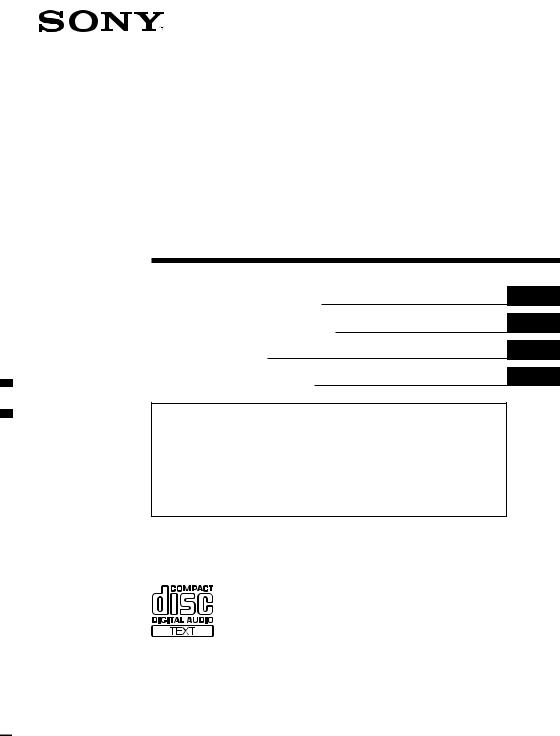
3-044-187-13 (1)
FM/MW/LW
Compact Disc
Player
Operating Instructions
Manual de instrucciones
Bruksanvisning
Manual de instruções
GB
ES
SE
PT
For installation and connections, see the supplied installation/connections manual.
Para obtener información sobre la instalación y las conexiones, consulte el manual de instalación/conexiones suministrado.
Vi hänvisar till det medföljande häftet angående montering/anslutningar.
Para a instalação e as ligações, consulte o manual de instalação/ligações fornecido.
CDX-4000RX CDX-4000RV CDX-4000R CDX-3900R
© 2000 Sony Corporation

Welcome !
Thank you for purchasing the Sony Compact Disc Player. This unit lets you enjoy a variety of features using the following controller accessories:
Optional accessories
Rotary commander RM-X4S
Precautions
CLASS 1
LASER PRODUCT
This label is located on the bottom of the chassis.
CAUTION INVISIBLE LASER RADIATION WHEN OPEN DO NOT STARE INTO BEAM OR
VIEW DIRECTLY WITH OPTICAL INSTRUMENTS
This label is located on the drive unit’s internal chassis.
•If your car was parked in direct sunlight resulting in a considerable rise in temperature inside the car, allow the unit to cool off before operating it.
•If no power is being supplied to the unit, check the connections first. If everything is in order, check the fuse.
•If your car is equipped with a power aerial, it will extend automatically while the unit is operating.
If you have any questions or problems concerning your unit that are not covered in this manual, please consult your nearest Sony dealer.
Moisture Condensation
On a rainy day or in a very damp area, moisture may condense on the lenses inside the unit. Should this occur, the unit will not operate properly. In such a case, remove the disc and wait for about an hour until the moisture has evaporated.
To maintain high quality sound
If you have drink holders near your audio equipment, be careful not to splash juice or other soft drinks onto the unit and CD. Sugary residues on the unit or CD may contaminate the lenses inside the unit, reduce the sound quality, or prevent sound reproduction altogether.
2
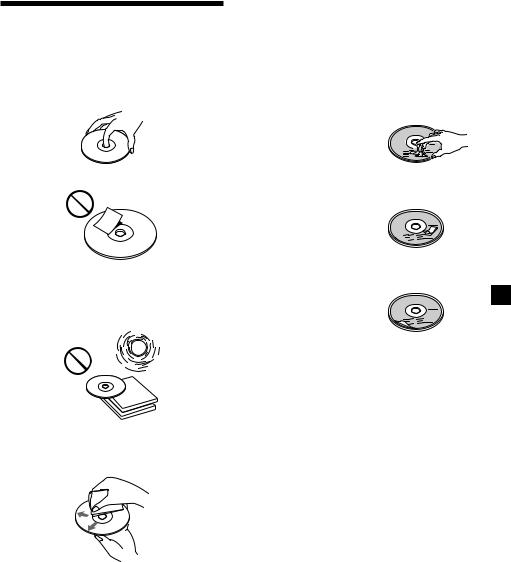
Notes on CDs
A dirty or defective disc may cause sound dropouts while playing. To enjoy optimum sound, handle the disc as follows.
Handle the disc by its edge. To keep the disc clean, do not touch the surface.
Do not stick paper or tape on the disc.
Do not expose the discs to direct sunlight or heat sources such as hot air-ducts, or leave them in a car parked in direct sunlight where there can be a considerable rise in temperature inside the car.
Before playing, clean the discs with an optional cleaning cloth. Wipe each disc from the center out.
Do not use solvents such as benzine, thinner, commercially available cleaners, or antistatic spray intended for analog discs.
Notes on discs
If you use the discs explained below, the sticky residue can cause the CD to stop spinning and may cause malfunction or ruin your discs.
Do not use second-hand or rental CDs that have a sticky residue on the surface (for example, from peeled-off stickers or from ink, or glue leaking from under the stickers).
There are paste residue.
Ink is sticky.
Do not use rental CDs with old labels that are beginning to peel off.
Stickers that are beginning to peel away, leaving a sticky residue.
Do not use your CDs with labels or stickers attached.
Labels are attached.
Notes on CD-R discs
•You can play CD-Rs (recordable CDs) on this unit. However depending on the conditions of the recording equipment or the CD-R disc itself, some CD-Rs cannot be played on this unit.
•You cannot play a CD-R that is not finalized (Finalization is necessary for a recorded CD- R disc to be played on the audio CD player).
•You cannot play CD-RWs (rewritable CDs) on this player.
When you play 8 cm (3 in.) CDs
Use the optional Sony compact disc single adaptor (CSA-8) to protect the CD player from damage.
3

Table of Contents |
|
Location of controls ............................................. |
5 |
Getting Started |
|
Resetting the unit ................................................. |
6 |
Detaching the front panel ................................... |
6 |
Turning the unit on/off ....................................... |
7 |
How to use the menu .......................................... |
7 |
Setting the clock ................................................... |
7 |
CD Player |
|
Listening to a CD ................................................. |
8 |
Playing a CD in various modes ....................... |
10 |
Radio |
|
Memorising stations automatically |
|
— Best Tuning Memory (BTM) ................... |
10 |
Memorising only the desired stations ............. |
11 |
Receiving the memorised stations ................... |
11 |
RDS |
|
Overview of the RDS function ......................... |
12 |
Displaying the station name ............................. |
12 |
Retuning the same programme automatically |
|
— Alternative Frequencies (AF) ................. |
13 |
Listening to traffic announcements ................. |
14 |
Presetting the RDS stations with the AF and |
|
TA data ........................................................... |
15 |
Locating a station by programme type ........... |
16 |
Setting the clock automatically ........................ |
17 |
Other Functions |
|
Labelling the rotary commander (optional) ... |
17 |
Using the rotary commander (optional) ......... |
18 |
Adjusting the sound characteristics ................ |
19 |
Attenuating the sound ...................................... |
20 |
Changing the sound and display settings ...... |
20 |
Boosting the bass sound |
|
— D-bass ........................................................ |
21 |
Additional Information |
|
Maintenance ........................................................ |
21 |
Dismounting the unit ........................................ |
22 |
Specifications ...................................................... |
23 |
Troubleshooting guide ...................................... |
24 |
4
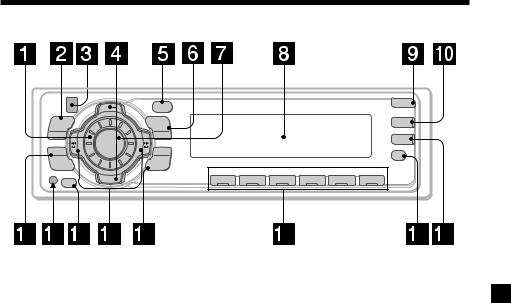
Location of controls
MENU
SOUND
OFF
PR |
S |
T + |
SOURCE
PRST–
PTY |
DSPL |
|
|
|
|
OPEN |
|
|
|
|
|
|
|
|
MODE |
|
|
|
|
D-BASS |
|
-SEEK/AMS |
|
|
|
|
TA |
|
|
|
|
|
|
|
|
|
|
|
|
|
AF |
ENTER |
|
|
|
|
|
|
|
REP |
SHUF |
|
|
|
|
|
1 |
2 |
3 |
4 |
5 |
6 |
CDX-4000RX/4000RV /4000R/3900R
Refer to the pages listed for details.
1 Volume control dial 15
2MENU button 7, 9, 10, 11, 12, 14, 15, 17, 20
3Z (eject) button (located on the front side of the unit behind the front panel) 8
4PRST +/– (cursor up/down) buttons 7, 9, 10, 11, 12, 14, 15, 17, 20
During radio reception: Preset stations select 11, 16
5DSPL/PTY (display mode change/ programme type) button 8, 9, 13, 16
6MODE button 15 During radio reception:
BAND select 10, 11
7SOURCE (TUNER/CD) button 7, 8, 9, 10, 11
8 Display window
9 OPEN button 6, 8, 22
q; D-BASS button 21
qa SOUND button 19
qs Reset button (located on the front side of the unit behind the front panel) 6
qd OFF button* 6, 7, 8
qf SEEK/AMS –/+ (cursor left/right) buttons 7, 9, 11, 12, 14, 15, 17, 19, 20
Automatic Music Sensor 9 Manual Search 9
Seek 11, 13
qg ENTER button 7, 9, 10, 11, 12, 14, 15, 16, 17, 20
qh Number buttons During radio reception:
Preset number select 11, 14, 15 During CD playback:
(1)REP 10
(2)SHUF 10
qj AF button 13, 15
qk TA button 14, 15
*Warning when installing in a car without ACC (accessory) position on the ignition key switch
Be sure to press (OFF) on the unit for two seconds to turn off the clock display after turning off the engine.
When you press (OFF) only momentarily, the clock display does not turn off and this causes battery wear.
5
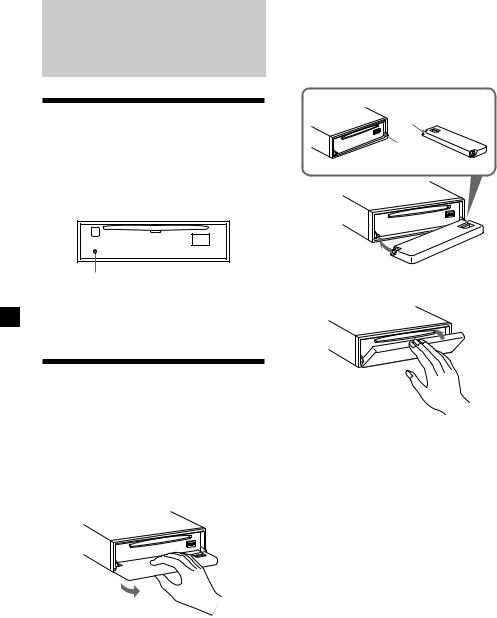
Getting Started
Resetting the unit
Before operating the unit for the first time or after replacing the car battery, you must reset the unit.
Remove the front panel and press the reset button with a pointed object, such as a ballpoint pen.
Reset button
Note
Pressing the reset button will erase the clock setting and some memorised functions.
Detaching the front panel
You can detach the front panel of this unit to protect the unit from being stolen.
1 Press (OFF).
2 Press (OPEN), then slide the front panel to the right side, and pull out the left side of the front panel.
1

2
Notes
•Do not put anything on the inner surface of the front panel.
•Be sure not to drop the panel when detaching it from the unit.
•If you detach the panel while the unit is still turned on, the power will turn off automatically to prevent the speakers from being damaged.
•When carrying the front panel with you, use the supplied front panel case.
Attaching the front panel
Place the hole A in the front panel onto the spindle B on the unit as illustrated, then push the left side in.
A
B
x
Notes
•Be careful not to attach the front panel upside down.
•Do not press the front panel too hard against the unit when attaching it.
•Do not press too hard or put excessive pressure on the display window of the front panel.
•Do not expose the front panel to direct sunlight or heat sources such as hot air ducts, and do not leave it in a humid place. Never leave it on the dashboard of a car parked in direct sunlight or where there may be a considerable rise in temperature.
Caution alarm
If you turn the ignition key switch to the OFF position without removing the front panel, the caution alarm will beep for a few seconds.
If you connect an optional power amplifier and do not use the built-in amplifier, the beep sound will be deactivated.
6
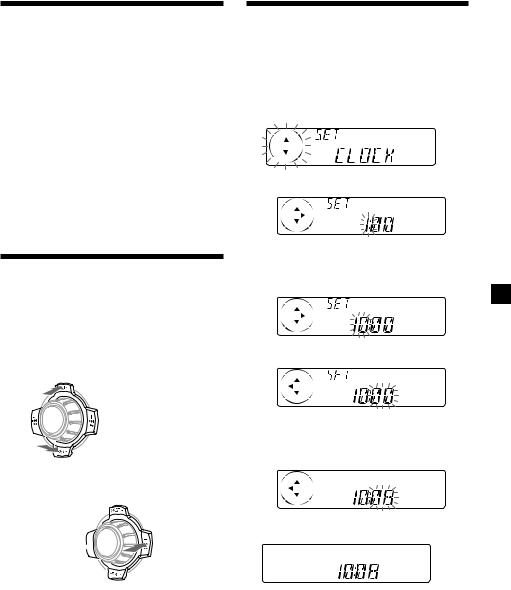
Turning the unit on/off
Turning on the unit
Press (SOURCE) or insert a CD in the unit. For details on operation, refer to page 8 (CD) and page 10 (radio).
Turning off the unit
Press (OFF) to stop CD playback or radio reception (the key illumination and display remain on.)
Press (OFF) for two seconds to completely turn the unit off.
Note
If your car has no ACC position on the ignition key switch, be sure to turn the unit off by pressing (OFF) for two seconds to avoid car battery wear.
How to use the menu
This unit is operated by selecting items from a menu.
To select, first enter the menu mode and choose up/down ((+)/(–) of (PRST)), or choose left/right ((–)/(+) of (SEEK/AMS)).
(PRST)
(+): to select upwards
Setting the clock
The clock uses a 24-hour digital indication.
Example: To set the clock to 10:08
1 Press (MENU), then press either side of (PRST) repeatedly until “CLOCK” appears.
1 Press (ENTER).
The hour indication flashes.
2Press either side of (PRST) to set the hour.
3 Press the (+) side of (SEEK/AMS).
SOURCE
The minute indication flashes.
(–): to select downwards |
4 Press either side of (PRST) to set the |
|
minute. |
||
|
(SEEK/AMS)
(–): to select leftwards
SOURCE
(+): to select |
2 Press (ENTER). |
rightwards |
|
Note
In Menu mode the “v” in the left of the display indicates the selectable buttons of (PRST) and
(SEEK/AMS).
The clock starts.
After the clock setting is completed, the display returns to normal play mode.
Tip
You can set the clock automatically with the RDS feature (see page 12).
Note
When the D.INFO mode is set to ON, the time is always displayed, provided that the M.DSPL is set
to OFF (page 20).
7
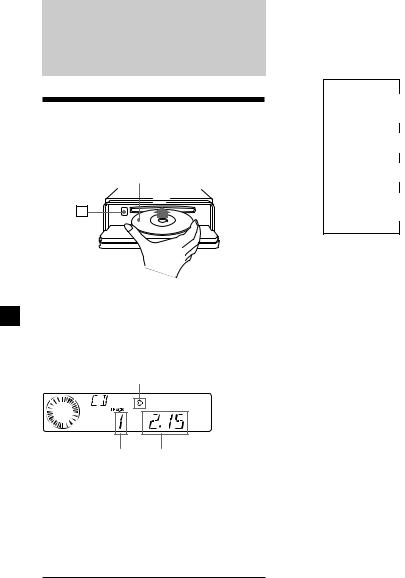
CD Player
Listening to a CD
(with this unit only)
1 Press (OPEN) and insert the CD.
Labelled side up
Z
2 Close the front panel.
Playback starts automatically.
If a CD is already inserted, press (SOURCE) repeatedly until “CD” appears to start playback.
CD indication
Track number |
Elapsed playing time |
When the last track on the CD is over
The track number indication returns to “1,” and playback restarts from the first track of the CD.
To |
Press |
Stop playback |
(OFF) |
Eject the CD |
(OPEN) then Z |
Changing the display item
Each time you press (DSPL/PTY) during CD TEXT disc playback, the item changes as follows:
V
Track number/
Elapsed playback time
V
Disc name/Artist name*1
V
Track name*2
V
FM1 frequency or station name*3
*1 If you play a CD TEXT disc, the artist name appears in the display after the disc name. (Only for CD TEXT discs with the artist name.)
*2 If the track name of a CD TEXT disc is not prerecorded, “TRACK“ and “NO NAME” appear in the display.
*3 While the AF/TA function is activated.
After you select the desired item, the display will automatically change to the Motion Display mode after a few seconds.
In the Motion Display mode, all the items are scrolled in the display one by one in order.
Tip
The Motion Display mode can be turned off. (See “Changing the sound and display settings” on page 20).
8
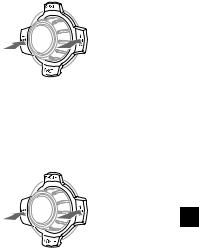
Automatically scrolling a disc name
— Auto Scroll
If the disc name, artist name, or track name on a CD TEXT disc exceeds 8 characters and the Auto Scroll function is on, information automatically scrolls across the display as follows:
•The disc name appears when the disc has changed (if the disc name is selected as the display item).
•The track name appears when the track has changed (if the track name is selected as the display item).
•The disc or track name appears depending on the setting when you press (SOURCE) to select a CD TEXT disc.
If you press (DSPL/PTY) to change the display item, the disc or track name of the CD TEXT disc is scrolled automatically whether you set the function on or off.
1 During playback, press (MENU).
2 Press either side of (PRST) repeatedly until “A.SCRL-OFF” appears.
3 Press the (+) side of (SEEK/AMS) to select “A.SCRL-ON.”
4 Press (ENTER).
To cancel Auto Scroll, select “A.SCRL-OFF” in step 3.
Note
For some CD TEXT discs with very many characters, the following cases may happen:
—Some of the characters are not displayed.
—Auto Scroll does not work.
Locating a specific track
—Automatic Music Sensor (AMS)
During playback, press either side of (SEEK/AMS) momentarily for each track you want to skip.
To locate |
|
To locate |
|
preceding |
SOURCE |
succeeding |
|
tracks |
tracks |
||
|
Locating a specific point in a track
—Manual Search
During playback, press and hold either side of (SEEK/AMS). Release when you have found the desired point.
To search |
|
To search |
backward |
SOURCE |
forward |
Note
If “






 ” or “
” or “






 ” appears in the display, you have reached the beginning or the end of the disc and you cannot go any further.
” appears in the display, you have reached the beginning or the end of the disc and you cannot go any further.
9
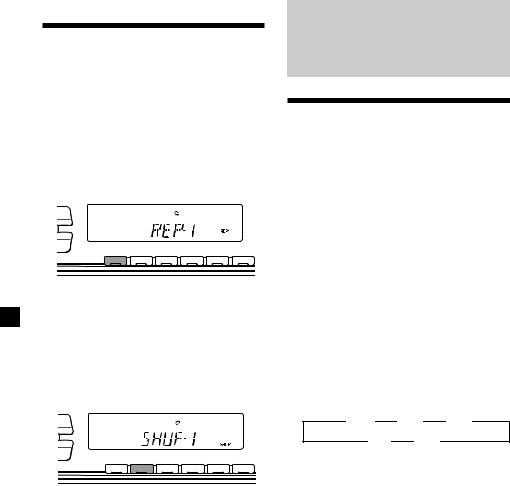
Playing a CD in various modes
You can play CDs in various modes:
•REP (Repeat Play) repeats the current track. •SHUF (Shuffle Play) plays all the tracks in
random order.
Playing tracks repeatedly
— Repeat Play
During playback, press (1) (REP).
PTY DSPL
MODE
-SEEK/AMS
ENTER
REP |
SHUF |
|
|
|
|
1 |
2 |
3 |
4 |
5 |
6 |
Repeat Play starts.
To return to normal play mode, select “REPOFF.”
Playing tracks in random order
— Shuffle Play
During playback, press (2) (SHUF).
PTY DSPL
MODE
-SEEK/AMS
ENTER
REP |
SHUF |
|
|
|
|
1 |
2 |
3 |
4 |
5 |
6 |
Shuffle Play starts.
To return to normal play mode, select “SHUFOFF.”
Radio
Memorising stations automatically
— Best Tuning Memory (BTM)
The unit selects the stations with the strongest signals and memorises them in the order of their frequencies. You can store up to 6 stations on each band (FM1, FM2, FM3, MW, and LW).
Caution
When tuning in stations while driving, use Best Tuning Memory to prevent accidents.
1 Press (SOURCE) repeatedly to select the tuner.
Each time you press (SOURCE), the source changes as follows:
Tuner y CD
2 Press (MODE) repeatedly to select the band.
Each time you press (MODE), the band changes as follows:
B FM1 B FM2 B FM3
LW b MW b
3 Press (MENU), then press either side of (PRST) repeatedly until “BTM” appears.
4 Press (ENTER).
The unit stores stations in the order of their frequencies on the number buttons.
A beep sounds when the setting is stored.
10

Notes
•The unit does not store stations with weak signals. If only a few stations can be received, some number buttons will retain their former setting.
•When a number is indicated in the display, the unit starts storing stations from the one currently displayed.
•If a CD is not in the unit, only the tuner band appears even if you press (SOURCE).
Memorising only the desired stations
You can preset up to 18 FM stations (6 each for FM1, FM2, and FM3), up to 6 MW stations, and up to 6 LW stations in the order of your choice.
1 Press (SOURCE) repeatedly to select the tuner.
2 Press (MODE) repeatedly to select the band.
3 Press either side of (SEEK/AMS) to tune in the station that you want to store on the number button.
4 Press the desired number button ((1) to
(6)) for two seconds until “MEM” appears.
The number button indication appears in the display.
Note
If you try to store another station on the same number button, the previously stored station will be erased.
Receiving the memorised stations
1 Press (SOURCE) repeatedly to select the tuner.
2 Press (MODE) repeatedly to select the band.
3 Press the number button ((1) to (6)) on which the desired station is stored.
Tip
Press either side of (PRST) to receive the stations in the order they are stored in the memory (Preset Search Function).
If you cannot tune in a preset station
Press either side of (SEEK/AMS) to search for the station (automatic tuning).
Scanning stops when the unit receives a station. Press either side of (SEEK/AMS) repeatedly until the desired station is received.
Note
If the automatic tuning stops too frequently, press (MENU), then press either side of (PRST) repeatedly until “LOCAL” (local seek mode) is displayed. Then press the (+) side of (SEEK/AMS) to select “LOCAL-ON.” Press (ENTER).
Only the stations with relatively strong signals will be tuned in.
Tips
•When you select the “LOCAL-ON” setting, “L.SEEK” appears while the unit is searching for a station.
•If you know the frequency of the station you want to listen to, press and hold either side of (SEEK/AMS) until the desired frequency appears (manual tuning).
11
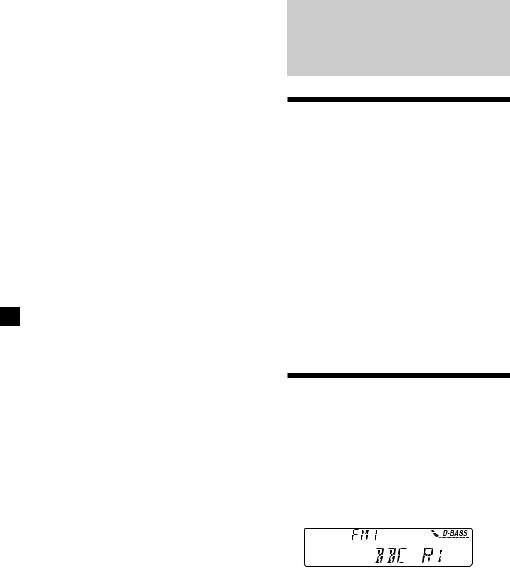
If FM stereo reception is poor
— Monaural Mode
1 During radio reception, press (MENU), then press either side of (PRST) repeatedly until “MONO-OFF” appears.
2 Press the (+) side of (SEEK/AMS) until “MONO-ON“ appears.
The sound improves, but becomes monaural (“ST” disappears).
3 Press (ENTER).
To return to normal mode, select “MONO-OFF” in step 2.
RDS
Overview of the RDS function
Radio Data System (RDS) is a broadcasting service that allows FM stations to send additional digital information along with the regular radio programme signal. Your car stereo offers you a variety of services. Here are just a few: retuning the same programme automatically, listening to traffic announcements, and locating a station by programme type.
Notes
•Depending on the country or region, not all of the RDS functions are available.
•RDS may not work properly if the signal strength is weak or if the station you are tuned to is not transmitting RDS data.
Displaying the station name
The name of the current station lights up in the display.
Select an FM station (page 11).
When you tune in an FM station that transmits RDS data, the station name appears in the display.
Note
The “*” indication means that an RDS station is being received.
12
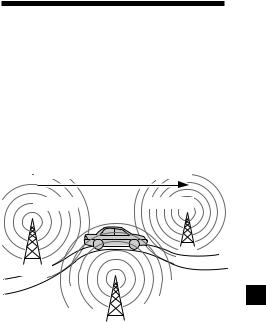
Changing the displayed item
Each time you press (DSPL/PTY), the item changes as follows:
Station Name (Frequency) y PTY data
After you select the desired item, the display will automatically change to the Motion Display mode after a few seconds.
In the Motion Display mode, all the items are scrolled in the display one by one in order.
Tip
The Motion Display mode can be turned off. (See “Changing the sound and display settings” on page 20.)
Note
“NO NAME” appears if the received station does not transmit RDS data.
Retuning the same programme automatically
— Alternative Frequencies (AF)
The Alternative Frequencies (AF) function automatically selects and retunes the station with the strongest signal in a network. By using this function, you can continuously listen to the same programme during a longdistance drive without having to retune the station manually.
Frequencies change automatically.
98.5MHz |
96.0MHz |
Station
102.5MHz
1 Select an FM station (page 11).
2 Press (AF) repeatedly until “AF-ON” appears.
The unit starts searching for an alternative station with a stronger signal in the same network.
Notes
•When there is no alternative station in the area and you do not need to search for an alternative station, turn the AF function off by pressing (AF) repeatedly until “AF-OFF” appears.
•When “NO AF” and the station name flash alternately, it means that the unit cannot find an alternative station in the network.
•If the station name starts flashing after selecting a station with the AF function on, this indicates that no alternative frequency is available. Press either side of (SEEK/AMS) while the station name is flashing (within eight seconds). The unit starts searching for another frequency with the same PI (Programme Identification) data (“PI SEEK” appears and no sound is heard). If the unit cannot find another frequency, “NO PI” appears, and the unit returns to the previously selected frequency.
13

Listening to a regional programme
The “REG-ON” (regional on) function lets you stay tuned to a regional programme without being switched to another regional station. (Note that you must turn the AF function on.) The unit is factory preset to “REG-ON,” but if you want to turn off the function, do the following.
1 During radio reception, press (MENU), then press either side of (PRST) repeatedly until “REG” appears.
2 Press the (+) side of (SEEK/AMS) until “REG-OFF” appears.
3 Press (ENTER).
Note that selecting “REG-OFF” might cause the unit to switch to another regional station within the same network.
To return to regional on, select “REG-ON” in step 2.
Note
This function does not work in the United Kingdom and in some other areas.
Local link function (United Kingdom only)
The Local Link function lets you select other local stations in the area, even if they are not stored on your number buttons.
1 Press a number button that has a local station stored on it.
2 Within five seconds, press the number button of the local station again.
3 Repeat this procedure until the desired local station is received.
Listening to traffic announcements
The Traffic Announcement (TA) and Traffic Programme (TP) data lets you automatically tune in an FM station that is broadcasting traffic announcements even if you are listening to other programme sources.
Press (TA) repeatedly until “TA-ON” appears.
The unit starts searching for traffic information stations. “TP” appears in the display when the unit finds a station broadcasting traffic announcements. When the traffic announcement starts, “TA” flashes. The flashing stops when the traffic announcement is over.
Tip
If the traffic announcement starts while you are listening to another programme source, the unit automatically switches to the announcement and goes back to the original source when the announcement is over.
Notes
•“NO TP” flashes for five seconds if the received station does not broadcast traffic announcements. Then, the unit starts searching for a station that broadcasts it.
•When “EON” appears with “TP” in the display, the current station makes use of broadcast traffic announcement of other stations in the same network.
14

To cancel the current traffic announcement
Press (TA), (SOURCE) or (MODE).
To cancel all traffic announcements, turn off the function by pressing (TA) until “TAOFF” appears.
Presetting the volume of traffic announcements
You can preset the volume level of the traffic announcements beforehand so you won’t miss the announcement. When a traffic announcement starts, the volume will be automatically adjusted to the preset level.
1 Turn the volume control dial to adjust the desired volume level.
2 Press (TA) for two seconds.
“TA” appears and the setting is stored.
Receiving emergency announcements
If an emergency announcement comes in while you are listening to the radio, the programme will be automatically switched to it. If you are listening to a source other than the radio, the emergency announcements will be heard if you set AF or TA to ON. The unit will then automatically switch to these announcements no matter which source you are listening to at the time.
Presetting the RDS stations with the AF and TA data
When you preset RDS stations, the unit stores each station’s data as well as its frequency, so you don’t have to turn on the AF or TA function every time you tune in the preset station. You can select a different setting (AF, TA, or both) for individual preset stations, or the same setting for all preset stations.
Presetting the same setting for all preset stations
1 Select an FM band (page 10).
2 Press (AF) and/or (TA) to select “AF-ON” and/or “TA-ON.”
Note that selecting “AF-OFF” or “TA-OFF” stores not only RDS stations, but also non-RDS stations.
3 Press (MENU), then press either side of (PRST) repeatedly until “BTM” appears.
4 Press the (+) side of (SEEK/AMS) until “BTM” flashes.
5 Press (ENTER).
Presetting different settings for each preset station
1 Select an FM band, and tune in the desired station (page 10).
2 Press (AF) and/or (TA) to select “AF-ON” and/or “TA-ON.”
3 Press the desired number button until “MEM” appears.
Repeat from step 1 to preset other stations.
15
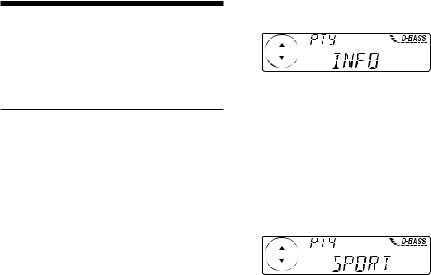
Locating a station by programme type
You can locate the station you want by selecting one of the programme types shown below.
|
|
Programme types |
Display |
|
|
News |
NEWS |
|
|
Current Affairs |
AFFAIRS |
|
|
Information |
INFO |
|
|
Sports |
SPORT |
|
|
Education |
EDUCATE |
|
|
Drama |
DRAMA |
|
|
Culture |
CULTURE |
|
|
Science |
SCIENCE |
|
|
Varied |
VARIED |
|
|
Popular Music |
POP M |
|
|
Rock Music |
ROCK M |
|
|||
|
|
Easy Listening |
EASY M |
|
|||
|
|
Light Classical |
LIGHT M |
|
|
Classical |
CLASSICS |
|
|
Other Music Type |
OTHER M |
|
|
Weather |
WEATHER |
|
|
Finance |
FINANCE |
|
|
Children’s Programmes |
CHILDREN |
|
|
Social Affairs |
SOCIAL A |
|
|
Religion |
RELIGION |
|
|
Phone In |
PHONE IN |
|
|
Travel |
TRAVEL |
|
|
Leisure |
LEISURE |
|
|
Jazz Music |
JAZZ |
|
|
Country Music |
COUNTRY |
|
|
National Music |
NATION M |
|
|
Oldies Music |
OLDIES |
|
|
Folk Music |
FOLK M |
|
|
Documentary |
DOCUMENT |
|
|
Not specified |
NONE |
Note
You cannot use this function in some countries where no PTY (Programme Type selection) data is available.
1 Press (DSPL/PTY) during FM reception until “PTY” appears.
The current programme type name appears if the station is transmitting the PTY data. “- - - - -” appears if the received station is not an RDS station, or if the RDS data has not been received.
2 Press (PRST) repeatedly until the desired programme type appears.
The programme types appear in the order shown in the above table. Note that you cannot select “NONE” (Not specified) for searching.
3 Press (ENTER).
The unit starts searching for a station broadcasting the selected programme type.
16
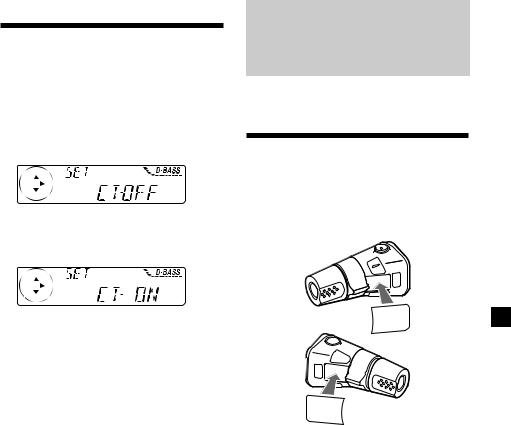
Setting the clock automatically
The CT (Clock Time) data from the RDS transmission sets the clock automatically.
1 During radio reception, press (MENU), then press either side of (PRST) repeatedly until “CT” appears.
2 Press the (+) side of (SEEK/AMS) repeatedly until “CT-ON” appears.
The clock is set.
3 Press (ENTER) to return to the normal display.
To cancel the CT function
Select “CT-OFF” in step 2.
Notes
•The CT function may not work even though an RDS station is being received.
•There might be a difference between the time set by the CT function and the actual time.
Other Functions
You can also control the unit with a rotary commander.
Labelling the rotary commander (optional)
Depending on how you mount the rotary commander, attach the appropriate label as shown in the illustration below.
SOUND
MODE
DSPL
DSPL
MODE
SOUND
17
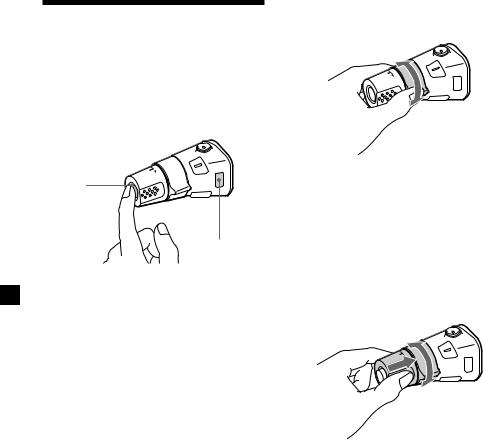
Using the rotary commander (optional)
By rotating the control (the SEEK/AMS control)
The rotary commander works by pressing buttons and/or rotating controls.
By pressing buttons
(the SOURCE and MODE buttons)
(SOURCE)
(MODE)
Each time you press (SOURCE), the source changes as follows:
Tuner t CD
Pressing (MODE) changes the operation in the following ways:
• Tuner: FM1 t FM2 t FM3 t MW t LW
Rotate the control momentarily and release it to:
•Locate a specific track on a disc. Rotate and hold the control until you locate the specific point in a track, then release it to start playback.
•Tune in stations automatically. Rotate and hold the control to find a specific station.
By pushing in and rotating the control (the PRESET/DISC control)
Push in and rotate the control to:
•Receive the stations memorised on the number buttons.
•Change the disc.
18
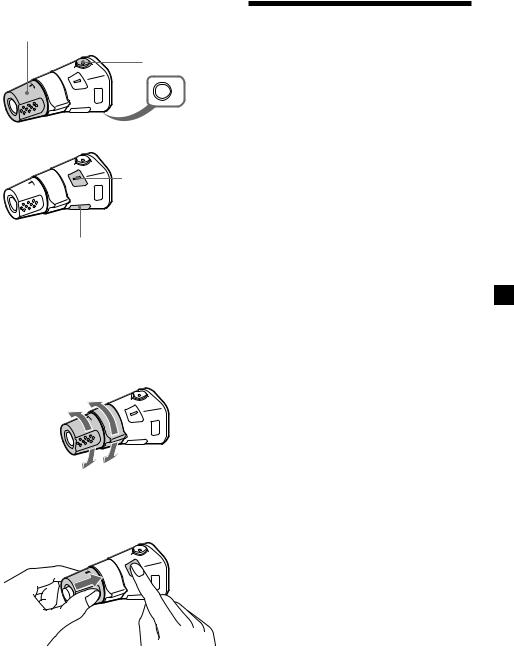
Other operations |
|
Rotate the VOL control to |
|
adjust the volume. |
Press (ATT) to |
|
|
|
attenuate the |
|
sound. |
|
OFF |
|
Press (OFF) to |
|
turn off the unit. |
|
Press (SOUND) to |
|
adjust the volume and |
|
sound menu. |
Press (DSPL) to display the memorised names.
Tip
If your car has no ACC (accessory) position on the ignition key switch, be sure to press (OFF) for two seconds to turn off the clock indication after turning off the engine.
Changing the operative direction
The operative direction of controls is factoryset as shown below.
To increase
To decrease
Adjusting the sound characteristics
You can adjust the bass, treble, balance, and fader.
You can store the bass and treble levels independently for each source.
1 Select the item you want to adjust by pressing (SOUND) repeatedly.
Each time you press (SOUND), the item changes as follows:
BAS (bass) t TRE (treble) t BAL (left-right) t FAD (front-rear)
2 Adjust the selected item by pressing either side of (SEEK/AMS).
When adjusting with the rotary commander, press (SOUND) and rotate the VOL control.
Note
Adjust within three seconds after selecting the item.
If you need to mount the rotary commander on the right hand side of the steering column, you can reverse the operative direction.
Press (SOUND) for two seconds while pushing the VOL control.
Tip
You can also change the operative direction of these controls with the unit (see “Changing the
sound and display settings” on page 20).
19

Attenuating the sound
(with the rotary commander-optional)
Press (ATT) on the rotary commander.
“ATT-ON” flashes momentarily.
To restore the previous volume level, press (ATT) again.
Tip
When the interface cable of a car telephone is connected to the ATT lead, the unit decreases the volume automatically when a telephone call comes in (Telephone ATT function). (CDX-4000RX/4000RV/ 4000R only)
Changing the sound and display settings
The following items can be set:
SET (setting)
•CLOCK (page 7)
•CT (Clock Time) (page 17)
•BEEP — to turn the beeps on or off.
•RM (Rotary Commander) — to change the operative direction of the controls of the rotary commander.
—Select “NORM” to use the rotary commamder as the factory-set position.
—Select “REV” when you mount the rotary commander on the right side of the steering column.
DIS (display)
•AMBER/GREEN — to change the illumination colour to amber or green. (CDX-4000R/3900R only)
•D.INFO (Dual Information) — to display the clock and the play mode at the same time (ON).
•DIMMER — to dim the display (ON) or not (OFF). (CDX-4000RV only)
•M.DSPL (Motion Display) — to turn the motion display on or off.
•A.SCRL (Auto Scroll) (page 9)
Note
If you connect an optional power amplifier and do not use the built-in amplifier, the beep sound will be disabled.
1 Press (MENU).
2 Press either side of (PRST) repeatedly until the desired item appears.
Each time you press the (–) side of (PRST), the item changes as follows:
CLOCK t CT t BEEP t RM t AMBER/GREEN*1 t D.INFO t DIMMER*2 t M.DSPL t A.SCRL*3
*1 CDX-4000R/3900R only *2 CDX-4000RV only
*3 When no CD TEXT disc is playing, this item will not appear.
Note
The displayed item will differ depending on the source.
Tip
You can easily switch among categories (“SET“, “DIS“, “P/M“ (play mode), and “EDT“ (edit mode)) by pressing either side of (PRST) for two seconds.
3 Press the (+) side of (SEEK/AMS) to select the desired setting (Example: ON or OFF).
4 Press (ENTER).
After the mode setting is completed, the display returns to normal play mode.
20
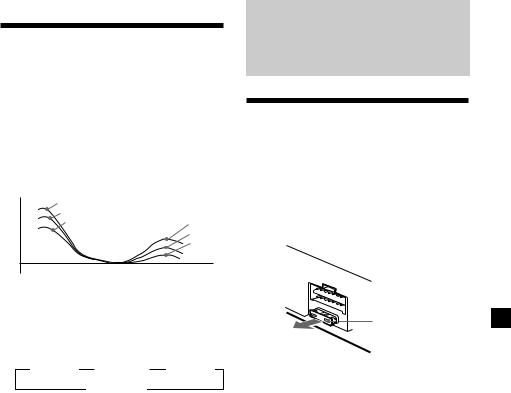
Boosting the bass sound
— D-bass
You can enjoy a clear and powerful bass sound.
The D-bass function boosts the low and high frequency signal with a sharper curve than conventional bass boost.
You can hear the bass line more clearly even while the vocal volume remains the same. You can emphasize and adjust the bass sound easily with the D-BASS button.
Level |
D-BASS 3 |
|
D-BASS 2 |
|
|
|
D-BASS 1 |
D-BASS 3 |
|
|
D-BASS 2 |
|
|
D-BASS 1 |
0dB
Frequency (Hz)
Adjusting the bass curve
Press (D-BASS) repeatedly until the desired bass level (1, 2, or 3) appears in the display.
B D.BASS 1 B D.BASS 2 B D.BASS 3
D.BASS-OFF b
To cancel, select “D.BASS-OFF.”
Note
If the bass sound becomes distorted, select a less effective setting of “D.BASS” or adjust the volume.
Additional
Information
Maintenance
Fuse replacement
When replacing the fuse, be sure to use one matching the amperage rating stated on the original fuse. If the fuse blows, check the power connection and replace the fuse. If the fuse blows again after replacement, there may be an internal malfunction. In such a case, consult your nearest Sony dealer.
Fuse (10 A)
Warning
Never use a fuse with an amperage rating exceeding the one supplied with the unit as this could damage the unit.
21
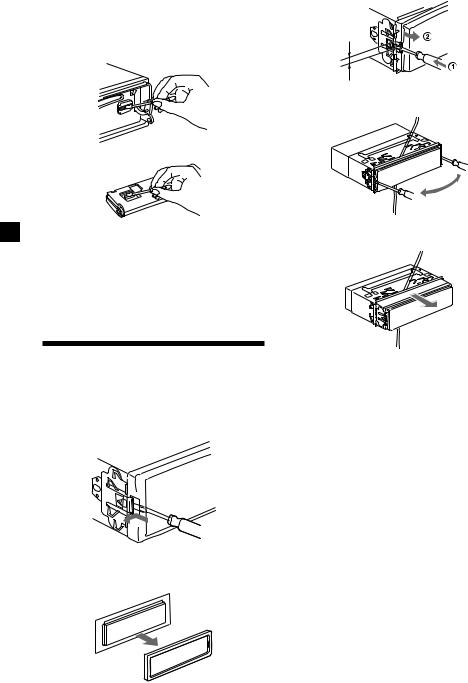
Cleaning the connectors
The unit may not function properly if the connectors between the unit and the front panel are not clean. In order to prevent this, open the front panel by pressing (OPEN), then detach it and clean the connectors with a cotton swab dipped in alcohol. Do not apply too much force. Otherwise, the connectors may be damaged.
Main unit
Back of the front panel
Notes
•For safety, turn off the engine before cleaning the connectors, and remove the key from the ignition switch.
•Never touch the connectors directly with your fingers or with any metal device.
Dismounting the unit
1 After taking off the front panel, press the clip inside the front cover with a thin screwdriver, and gently pry the front cover free.
2 Repeat step 1 for the right side.
The front cover is removed.
3 Use a thin screwdriver to push in the clip on the left side of the unit, then pull out the left side of the unit until the catch clears the mounting.
4 mm
4 Repeat step 3 for the right side.
5 Slide the unit out of its mounting.
22

Specifications
CD player section
Signal-to-noise ratio |
90 dB |
Frequency response |
10 – 20,000 Hz |
Wow and flutter |
Below measurable limit |
Tuner section
FM
Tuning range |
87.5 – 108.0 MHz |
Aerial terminal |
External aerial connector |
Intermediate frequency |
10.7 MHz/450 kHz |
Usable sensitivity |
8 dBf |
Selectivity |
75 dB at 400 kHz |
Signal-to-noise ratio |
66 dB (stereo), |
|
72 dB (mono) |
Harmonic distortion at 1 kHz |
|
|
0.6 % (stereo), |
|
0.3 % (mono) |
Separation |
35 dB at 1 kHz |
Frequency response |
30 – 15,000 Hz |
MW/LW
Tuning range |
MW: 531 – 1,602 kHz |
|
LW: 153 – 279 kHz |
Aerial terminal |
External aerial connector |
Intermediate frequency |
10.7 MHz/450 kHz |
Sensitivity |
MW: 30 µV |
|
LW: 40 µV |
Power amplifier section
Outputs |
Speaker outputs |
|
(sure seal connectors) |
Speaker impedance |
4 – 8 ohms |
Maximum power output |
50 W × 4 (at 4 ohms) |
General
Outputs |
Audio outputs |
|
|
|
Power aerial relay control |
||
|
lead |
|
|
|
Power amplifier control |
||
|
lead |
|
|
|
Telephone ATT control |
||
|
lead* |
|
|
Tone controls |
Bass ±9 dB at 100 Hz |
||
|
Treble ±9 dB at 10 kHz |
||
Power requirements |
12 V DC car battery |
||
|
(negative ground) |
|
|
Dimensions |
Approx. 178 × |
50 × |
183 mm |
|
(w/h/d) |
|
|
Mounting dimensions |
Approx. 182 × |
53 × |
162 mm |
|
(w/h/d) |
|
|
Mass |
Approx. 1.2 kg |
|
|
Supplied accessories |
Parts for installation and |
||
|
connections (1 set) |
|
|
|
Front panel case (1) |
||
Optional accessories |
Rotary commander |
||
|
RM-X4S |
|
|
* CDX-4000RX/4000RV/4000R only
Design and specifications are subject to change without notice.
23

Troubleshooting guide
The following checklist will help you remedy the problems you may encounter with your unit. Before going through the checklist below, check the connection and operating procedures.
General
Problem |
Cause/Solution |
|
|
No sound. |
•Cancel the ATT function. |
|
•Set the fader control to the centre position for two-speaker |
|
system. |
|
•Rotate the dial clockwise to adjust the volume. |
The contents of the memory have been erased.
•The power cord or battery has been disconnected. •The reset button has been pressed.
t Store again into the memory.
|
|
Indications do not appear in the Remove the front panel and clean the connectors. See |
|
|
|
display. |
“Cleaning the connectors” (page 22) for details. |
|
|
|
|
|
|
No beep sound. |
•The beep sound is cancelled (page 20). |
|
|
|
•If you connect an optional amplifier and do not use the built- |
|
|
|
in amplifier, the beep sound will be deactivated. |
|
|
|
|
|
|
|
|
|
|
|
|
CD playback
Problem |
Cause/Solution |
|
|
A disc cannot be loaded. |
•Another CD is already loaded. |
|
•The CD is forcibly inserted upside down or in the wrong |
|
way. |
|
|
Playback does not begin. |
Defective or dirty CD. |
|
|
A disc is automatically ejected. |
The ambient temperature exceeds 50°C. |
|
|
CD will not be ejected. |
You have closed the front panel or pushed the disc forcibly |
|
into the unit while the unit was ejecting the disc after you |
|
pressed Z. |
|
t Press the reset button. |
|
|
The operation buttons do not |
Press the reset button. |
function. |
|
|
|
The sound skips due to |
•The unit is installed at an angle of more than 60°. |
vibration. |
•The unit is not installed in a sturdy part of the car. |
The sound skips. |
A dirty or defective disc. |
|
|
24

Radio reception
Problem |
Cause/Solution |
|
|
Preset tuning is not possible. |
•Store the correct frequency in the memory. |
|
•The broadcast signal is too weak. |
|
|
The stations cannot be received. |
Connect a power aerial control lead (blue) or accessory power |
The sound is hampered by |
supply lead (red) to the power supply lead of a car’s aerial |
noises. |
booster. (Only when your car has built-in FM/MW/LW aerial |
|
in the rear/side glass.) |
|
|
Automatic tuning is not |
The broadcast signal is too weak. |
possible. |
t Use manual tuning. |
The “ST” indication flashes. |
•Tune in the frequency accurately. |
|
•The broadcast signal is too weak. |
|
t Set to the MONO mode (page 12). |
|
|
RDS
Problem |
Cause/Solution |
|
|
The SEEK starts after a few |
The station is non-TP or has weak signal. |
|
|
seconds of listening. |
t Press (AF) or (TA) repeatedly until “AF-OFF” or |
|
|
|
“TA-OFF” appears. |
|
|
|
|
||
|
|
|
|
No traffic announcements. |
•Activate “TA.” |
|
|
|
|||
|
•The station does not broadcast any traffic announcements |
|
|
|
despite being TP. t Tune to another station. |
|
|
|
|
|
|
PTY displays “NONE.” |
The station does not specify the programme type. |
|
|
|
|
|
|
If the above-mentioned solutions do not help improve the situation, consult your nearest Sony dealer.
25
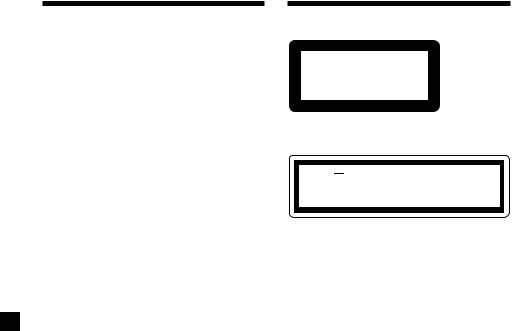
¡Bienvenido!
Gracias por adquirir el reproductor de discos compactos Sony. Esta unidad permite disfrutar de varias funciones mediante el uso de los siguientes accesorios de control:
Accesorios opcionales
Mando rotativo RM-X4S
Precauciones
CLASS 1
LASER PRODUCT
Esta etiqueta está situada en la parte inferior del chasis.
CAUTION INVISIBLE LASER RADIATION WHEN OPEN DO NOT STARE INTO BEAM OR
VIEW DIRECTLY WITH OPTICAL INSTRUMENTS
Esta etiqueta está situada en el chasis interno de la unidad de activación.
•Si aparca el automóvil bajo la luz solar directa y se produce un considerable aumento de temperatura en su interior, deje que la unidad se enfríe antes de utilizarla.
•Si la unidad no recibe alimentación, compruebe las conexiones en primer lugar. Si todo está en orden, examine el fusible.
•Si el automóvil dispone de antena motorizada, ésta se extenderá automáticamente durante el funcionamiento de la unidad.
Si desea realizar alguna consulta o solucionar algún problema referentes a la unidad que no aparezcan en este manual, póngase en contacto con el proveedor Sony más próximo.
Condensación de humedad
En días lluviosos o en zonas muy húmedas, es posible que se condense humedad en las lentes del interior de la unidad. Si esto ocurre, ésta no funcionará correctamente. En este caso, extraiga el disco y espere una hora aproximadamente hasta que se haya evaporado la humedad.
Para mantener una alta calidad de sonido
Si hay soportes para bebidas cerca del equipo de audio, tenga cuidado de no salpicar zumos y demás bebidas suaves sobre la unidad y el CD. Los residuos azucarados en la unidad o en el CD pueden ensuciar las lentes del interior de dicha unidad, reducir la calidad de sonido o impedir la reproducción de éste.
2
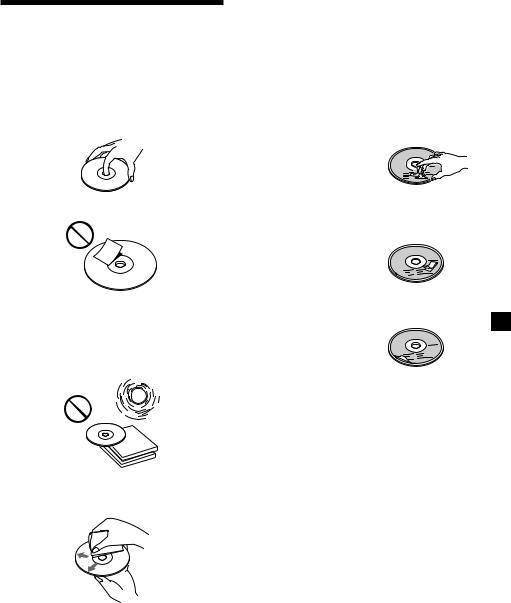
Notas sobre los discos compactos
Un disco sucio o defectuoso puede causar pérdidas de sonido durante la reproducción de CD. Para obtener un sonido óptimo, coja el disco de la siguiente forma.
Coja el disco por los bordes y no toque la superficie sin etiqueta.
No adhiera papel ni cinta en los discos.
No exponga los discos a la luz solar directa ni a fuentes térmicas, como conductos de aire caliente. No deje los discos en un automóvil aparcado bajo la luz solar directa, en cuyo interior pueda producirse un considerable aumento de temperatura.
Antes de reproducir un disco, frótelo con un paño limpiador opcional. Hágalo en la dirección de las flechas de la ilustración.
No utilice disolventes tales como bencina, diluyentes, limpiadores disponibles en las tiendas del ramo ni aerosoles destinados a discos analógicos.
Notas sobre los discos
Si emplea los discos descritos a continuación, el residuo adherente puede causar que el CD deje de girar y producir fallos de funcionamiento o dañar los discos.
No utilice discos compactos de segunda mano o de alquiler que tengan residuos adherentes en la superficie (por ejemplo, de adhesivos despegados o tinta, o de restos de pegamento de los adhesivos).
Residuos adherentes.
Tinta adherente.
No utilice discos compactos de alquiler con etiquetas viejas que estén comenzando a despegarse.
Adhesivos que empiezan a despegarse y dejan un residuo adherente.
No emplee discos compactos con etiquetas o adhesivos fijados.
Etiquetas adheridas.
Notas sobre discos CD-R
•Es posible reproducir discos CD-R (discos compactos grabables) en esta unidad. No obstante, algunos discos CD-R no podrán reproducirse en esta unidad en función de las condiciones del equipo de grabación o del propio disco CD-R.
•No es posible reproducir discos CD-R no finalizados (Es preciso que los discos CD-R grabados estén finalizados para poder reproducirse en el reproductor de CD de audio).
•No es posible reproducir discos CD-RW (discos compactos reescribibles) en este reproductor.
Reproducción de discos compactos de 8 cm
Utilice el adaptador opcional para discos compactos sencillos de Sony (CSA-8) para proteger el reproductor de CD contra daños.
3

Indice |
|
Localización de los controles .............................. |
5 |
Procedimientos iniciales |
|
Restauración de la unidad .................................. |
6 |
Extracción del panel frontal ................................ |
6 |
Activación/desactivación de la unidad ............ |
7 |
Utilización del menú ........................................... |
7 |
Ajuste del reloj ...................................................... |
7 |
Reproductor de CD |
|
Reproducción de un CD ...................................... |
8 |
Reproducción de un CD en diversos |
|
modos ............................................................. |
10 |
Radio |
|
Memorización automática de emisoras |
|
— Memorización de la mejor sintonía |
|
(BTM) ......................................................... |
10 |
Memorización de las emisoras deseadas ........ |
11 |
Recepción de emisoras memorizadas ............. |
11 |
RDS |
|
Descripción general de la función RDS .......... |
12 |
Visualización del nombre de la emisora ......... |
12 |
Resintonización automática del mismo |
|
programa |
|
— Frecuencias alternativas (AF) ................. |
13 |
Recepción de anuncios de tráfico .................... |
14 |
Programación de emisoras RDS con los datos |
|
AF y TA .......................................................... |
15 |
Localización de emisoras mediante el tipo de |
|
programa ........................................................ |
16 |
Ajuste automático del reloj ............................... |
17 |
Otras funciones |
|
Etiquetado del mando rotativo (opcional) ..... |
17 |
Uso del mando rotativo (opcional) .................. |
18 |
Ajuste de las características de sonido ............ |
19 |
Atenuación del sonido ...................................... |
20 |
Cambio de los ajustes de sonido y |
|
visualización .................................................. |
20 |
Refuerzo de los graves |
|
— D-bass ........................................................ |
21 |
Información complementaria |
|
Mantenimiento ................................................... |
21 |
Desmontaje de la unidad .................................. |
22 |
Especificaciones .................................................. |
23 |
Guía de solución de problemas ........................ |
24 |
4
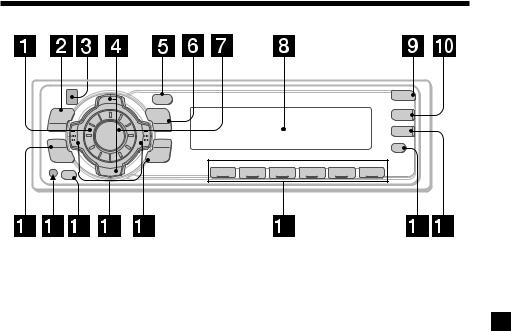
Localización de los controles
MENU
SOUND
OFF
PR |
S |
T + |
SOURCE
PRST–
PTY |
DSPL |
|
|
|
|
OPEN |
|
|
|
|
|
|
|
|
MODE |
|
|
|
|
D-BASS |
|
-SEEK/AMS |
|
|
|
|
TA |
|
|
|
|
|
|
|
|
|
|
|
|
|
AF |
ENTER |
|
|
|
|
|
|
|
REP |
SHUF |
|
|
|
|
|
1 |
2 |
3 |
4 |
5 |
6 |
CDX-4000RX/4000RV /4000R/3900R
Consulte las páginas indicadas para obtener más información.
1 Dial de control de volumen 15
2Botón MENU 7, 9, 10, 11, 12, 14, 15, 17, 20
3Botón Z (expulsión) (situado en la parte frontal de la unidad detrás del panel frontal) 8
4Botones PRST +/– (cursor arriba/abajo) 7, 9, 10, 11, 12, 14, 15, 17, 20
Durante la recepción de la radio: Selección de emisoras memorizadas 11, 16
5Botón DSPL/PTY (cambio del modo de indicación/tipo de programa) 8, 9, 13, 16
6Botón MODE 15
Durante la recepción de la radio: Selección de banda (BAND) 10, 11
7Botón SOURCE (TUNER/CD) 7, 8, 9, 10, 11
8 Visor
9 Botón OPEN 6, 8, 22
q; Botón D-BASS 21
qa Botón SOUND 19
qs Botón de restauración (situado en la parte frontal de la unidad detrás del panel frontal) 6
qd Botón OFF* 6, 7, 8
qf Botones SEEK/AMS –/+ (cursor izquierda/derecha)
7, 9, 11, 12, 14, 15, 17, 19, 20
Sensor de música automático 9 Búsqueda manual 9 Búsqueda 11, 13
qg Botón ENTER 7, 9, 10, 11, 12, 14, 15, 16, 17, 20
qh Botones numéricos
Durante la recepción de la radio: Selección de número de memorización
11, 14, 15
Durante la reproducción de CD:
(1)REP 10
(2)SHUF 10
qj Botón AF 13, 15
qk Botón TA 14, 15
*Advertencia sobre la instalación en un automóvil que no disponga de posición ACC (accesorios) en el interruptor de la llave de encendido
Asegúrese de pulsar (OFF) en la unidad durante dos segundos para desactivar la indicación del reloj después de apagar el motor.
Si pulsa (OFF) sólo momentáneamente, la indicación del reloj no se desactivará y esto causará el desgaste de la batería.
5
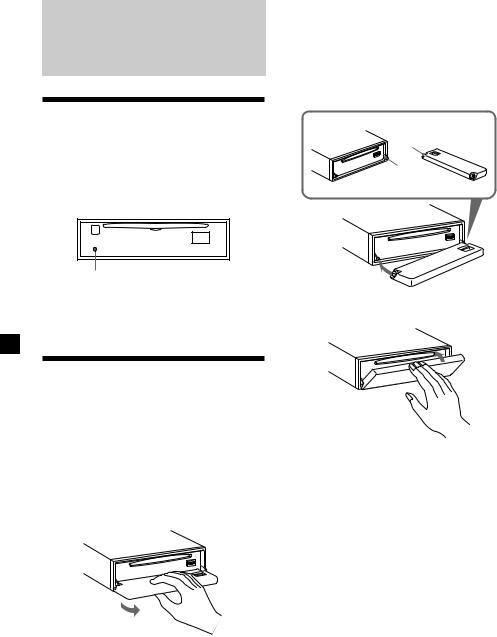
Procedimientos iniciales
Restauración de la unidad
Antes de utilizar la unidad por primera vez o después de sustituir la batería del automóvil, es necesario restaurar dicha unidad.
Extraiga el panel frontal y pulse el botón de restauración con un objeto puntiagudo, como por ejemplo un bolígrafo.
Botón de restauración
Nota
Al pulsar el botón de restauración se borrarán los ajustes del reloj y algunas funciones memorizadas.
Extracción del panel frontal
Es posible extraer el panel frontal de esta unidad para evitar su robo.
1 Pulse (OFF).
2 Pulse (OPEN), deslice el panel frontal hacia la derecha y tire del lado izquierdo del panel.
1

2
Notas
•No coloque nada en la superficie interior del panel frontal.
•Tenga cuidado para que el panel no se caiga cuando lo extraiga de la unidad.
•Si extrae el panel con la alimentación conectada, ésta se desconectará automáticamente para evitar que se dañen los altavoces.
•Para transportar el panel frontal, utilice el estuche suministrado para este fin.
Fijación del panel frontal
Coloque el orificio A del panel frontal en el eje B de la unidad como se ilustra y, a continuación, presione sobre el lado izquierdo para introducirlo.
A
B
x
Notas
•Tenga cuidado de no fijar el panel frontal al revés.
•No ejerza excesiva presión sobre el panel al fijarlo a la unidad.
•No sujete con demasiada fuerza ni presione excesivamente sobre el visor del panel frontal.
•No exponga el panel frontal a fuentes de calor directas como la luz solar o las salidas de aire caliente, ni lo deje en lugares húmedos. No lo deje nunca sobre el salpicadero de un automóvil aparcado bajo la luz solar directa, ya que podría producirse un considerable aumento de temperatura.
Alarma de precaución
Si gira el interruptor de la llave de encendido hasta la posición OFF sin haber extraído el panel frontal, la alarma de precaución emitirá pitidos durante unos segundos.
Si conecta un amplificador opcional de potencia y no utiliza el incorporado, los pitidos se desactivarán.
6
